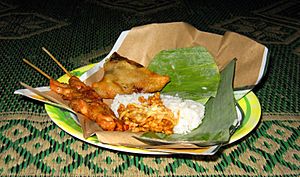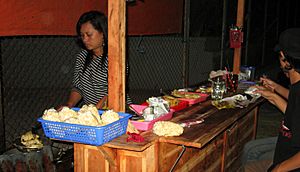Nasi kucing facts for kids
Nasi kucing (pronounced NAH-see KOO-ching) is a popular Indonesian rice dish. Its name means cat rice or cat's rice. It first came from cities like Yogyakarta, Semarang, and Surakarta. Today, you can find it in many places across Indonesia. It's a small portion of rice served with various yummy toppings. These often include spicy chili sauce, dried fish, and tempeh (a soy-based food). It's usually wrapped in a banana leaf for easy eating.
Contents
Why is it Called Cat Rice?
The name nasi kucing means "cat rice." This name comes from the small size of the rice serving. It's a very tiny amount, almost like the small portion of food someone might give to a pet cat.
Where Does Nasi Kucing Come From?
Nasi kucing first became popular in the cities of Yogyakarta, Semarang, and Surakarta. These are all on the island of Java in Indonesia. Now, you can find this dish in many other places. It's sold in big cities like Jakarta and even in Mecca, where Indonesian workers sell it during the hajj pilgrimage.
What's Inside Nasi Kucing?
The rice part of nasi kucing is quite small, usually about the size of your fist. It comes with different toppings to make it flavorful. Common toppings include sambal (a spicy chili sauce), dried fish, and tempeh. Sometimes, you might find toppings like egg, chicken, or cucumber. It's ready to eat right after you buy it. The dish is wrapped in a banana leaf and then in paper, making it easy to carry and enjoy.
Sego Macan: A Bigger Version
There's also a larger version of nasi kucing called sego macan. This name means "tiger's rice." It's about three times bigger than a regular nasi kucing portion. Sego macan often includes roasted rice, dried fish, and vegetables. Just like nasi kucing, sego macan is wrapped in a banana leaf and paper.
How is Nasi Kucing Sold?
Nasi kucing is usually sold at a very low price. Sometimes, it can cost as little as Rp 1000 (about US$ 0.12). The larger sego macan might cost around Rp 4000 (about US$ 0.48). This dish is often sold at small food stalls called angkringan. These stalls are usually found on the side of many roads.
Who Buys Nasi Kucing?
Many different people enjoy nasi kucing. Customers often include people who are looking for an affordable meal. This can be pedicab and taxi drivers, students, and street musicians. Because it's so affordable and easy to find, angkringan stalls are known as a place where everyone can get a good meal.
Running an Angkringan Stall
The people who own angkringan stalls often come from humble backgrounds. They might have limited job skills or come from small villages. To start their stalls, they often borrow money from a supporter, called a juragan. They might borrow up to Rp 900,000.00 (about US$ 105.00). The seller then repays the juragan using a small part of their daily earnings, which might be around Rp 15,000.00 to Rp 20,000.00 (about US$ 1.75 to 2.35) per day.



